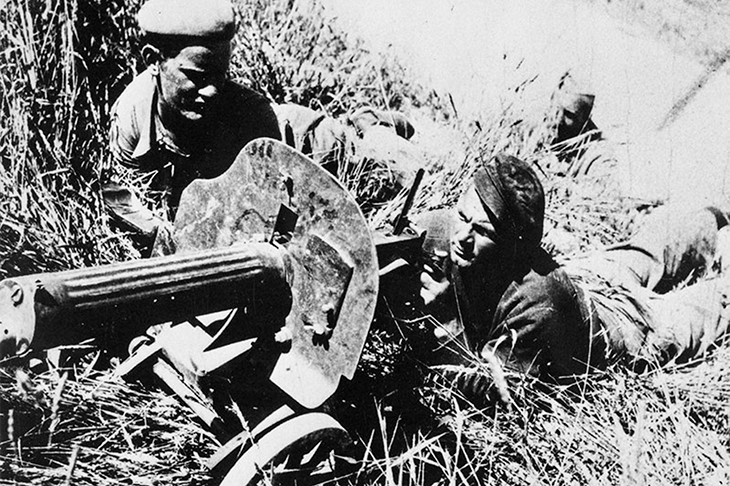During the Spanish civil war of 1936 to 1939, 35,000 men and women from around the world volunteered to fight against the forces of General Franco and his supporters from Fascist Italy and Nazi Germany. When the volunteers were withdrawn in September 1938 after two years of bitter fighting, more than a fifth of them had been killed and very few emerged unscathed.
Conflicts are by definition binary affairs, so it’s inevitable that bitterly contrasting views of the role of the International Brigades have existed ever since the civil war itself. For the volunteers and their supporters, their sacrifices were a ‘heroic example of democracy’s solidarity and universality’. Conversely, Francoist propagandists dismissed them as Red mercenaries, while the predominant role of the International Communist party, the Comintern, led to a long-standing belief that the International Brigades were a ‘Comintern army’, an agent of Stalin’s expansionism and terror.
However, in 1989 the opening up of masses of formerly secret documents held in the Russian State Archive of Socio-Political History (RGASPI) allowed scholars to question some of the more overly simplistic, black-and-white assumptions. The International Brigades: Fascism, Freedom and the Spanish Civil War by Giles Tremlett, a journalist based in Spain, is the latest to draw heavily on the material held in Moscow. Perhaps surprisingly, it’s the first study (in English, at least) for nearly 30 years to look at the International Brigades as a whole, rather than the individual national units.

Tremlett deftly interweaves this rich archival material with colourful first-hand accounts from numerous participants. This is no mean feat, given that this ‘Legion of Babel’ came from some 52 countries. The volunteers were divided by nationality, language and by political background; often the only thing they had in common was that they were anti-fascists. As Tremlett states, some were ‘devout’ believers in communism, others were ‘displaced’ migrants with personal experiences of fascism or Nazism. Many were both and some were neither.
By structuring his book around a chronological narrative of the Brigades’ role in the key battles over the course of the conflict, Tremlett sensibly places the war itself at the centre of the story. This may seem an obvious thing to do, but given the Soviet Union’s support for the Republic, Mussolini and Hitler’s support for Franco and the western democracies’ policy of non-intervention in the war (which even Francoists admitted worked to their advantage), all too often the actual visceral experiences of the volunteers in Spain (and the dynamic of the war itself) can become drowned out by the international context.
Though poorly led, the Brigades were among the Republic’s best fighters, and often used as shock troops
However, his engaging narrative does not prevent Tremlett from pausing to tackle difficult, awkward or controversial issues. This is commendable, but the warts and all approach does make for grim reading at times. He recounts in graphic detail how, despite being poorly trained, led and equipped, the Brigades were nonetheless some of the Republic’s best fighters and consequently used as shock troops, thrown ‘into the heart of the fire’. He also discusses the victimisation of political ‘deviants’, the endemic desertions, draconian punishments and the execution of deserters.
Some contrast is provided by tales from behind the line, including accounts of writers such as Ernest Hemingway and Martha Gelhorn and the photo-journalists Robert Capa and Gerda Taro. Also included is an outline of the important work of the Republican medical services, whose advances, such as the blood transfusion work of the pioneering Canadian doctor Norman Bethune, provided important lessons for the wider war which followed. And for a British readership brought up on George Orwell’s Homage to Catalonia, Tremlett includes
a very fair-minded description of the infamous Barcelona May Days, the suppression of the anti-Stalinist POUM and the horrifying murder of its leader by a professional NKVD assassin.
The book concludes with a very brief overview of the volunteers’ experiences post-Spain, when many continued their fight against fascism in the Allied forces or in resistance movements within occupied Europe. As the book makes clear, it is a sad irony that many veterans found themselves objects of suspicion both in the West and in the East, where a number suffered in the purges. Depressingly, others became the gaolers themselves, particularly in East Germany where Wilhelm Zaisser, known as General Gómez in Spain, founded the infamous secret police, the Stasi.
Overall, Tremlett’s history of the International Brigades is a highly engaging read, helped considerably by the author’s fluid prose style and journalist’s eye for a good story. More than 600 pages long, it is undoubtedly a well-researched and comprehensive work of scholarship. No doubt some — particularly in Spain — will see it as overly sympathetic to the Brigades and their cause, but I feel that the author’s summary is a fair one:
There was nothing perfect about the brigaders and attempts to paint them as 20th-century saints only serve to highlight their failings … all fought, however, against the most destructive and evil force unleashed by 20th-century Europe’s violent politics and history.






Comments